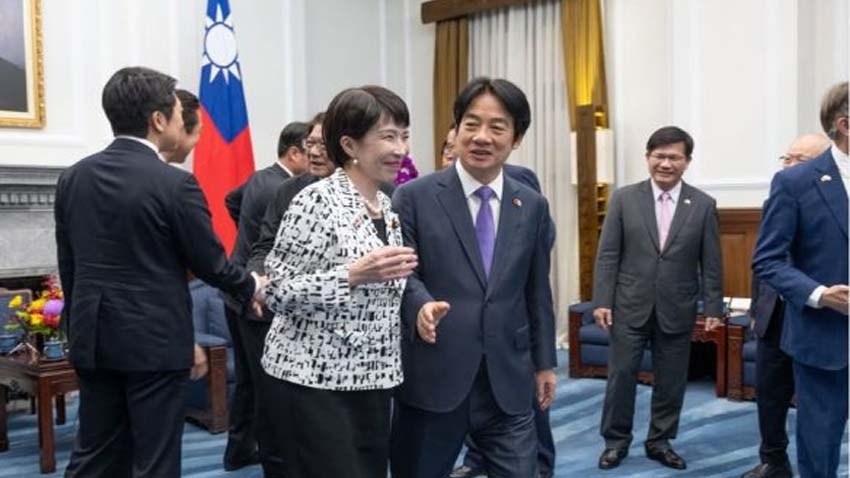Published: 12:01 PM, 29 October 2025
Why China Is Worried About Japan’s New Prime Minister
 LDP parliamentarian Takaichi Sanae (front left) walks with Taiwan’s President Lai Ching-te (front right) during a meeting in Taipei, Taiwan, on April 28, 2025.
LDP parliamentarian Takaichi Sanae (front left) walks with Taiwan’s President Lai Ching-te (front right) during a meeting in Taipei, Taiwan, on April 28, 2025.
Takaichi Sanae is hawkish on China, friendly toward Taiwan, and ultraconservative on historical issues. No wonder Beijing isn’t happy.
For the second time in as many years, Japan has a new leader, and Beijing is watching warily. Takaichi Sanae, now the head of Japan’s ruling Liberal Democratic Party (LDP), has made history by becoming the country’s first female prime minister.
In a nation long dominated by male politicians, her rise shatters a glass ceiling. But beyond the symbolism, Takaichi’s leadership signals a potential shift in Japan’s domestic politics, regional posture, and approach toward China.
Takaichi is widely regarded as an ultraconservative and a political hardliner, aligned with former Prime Minister Abe Shinzo. Her worldview mirrors Abe’s: assertive on defense, hawkish on China, and keen to bolster Japan’s role in the Indo-Pacific. While allies and partners may welcome her clarity, assertiveness and decisiveness, Beijing is already wary of her ascendence to power.
She has consistently framed China as a strategic threat. Issues such as Taiwan and the historical memory, which have long been points of tension, are expected to see more rigid policies under her leadership. Past Japanese leaders have warned that any conflict over Taiwan could directly affect Japan’s security, a stance Takaichi is likely to reinforce. Meanwhile, Takaichi has repeatedly visited Yasukuni Shrine, which honors Japan’s war dead, and has refused to rule out a similar visit during her time as prime minister.
Her rise comes at a sensitive historical juncture. This year marks the 80th anniversary of China’s victory in the People’s War of Resistance Against Japanese Aggression, a memory that continues to shape Chinese leadership and public sentiment. China held a victory parade with over 25 world leaders present to mark the event.
On Chinese social media, Takaichi is labeled as “anti-China” and an “extreme right-winger.” Chinese critics accuse her of smearing China, denying the Nanjing Massacre, exaggerating the so-called “China threat,” and stoking controversy over Taiwan. Analysts in Beijing are particularly wary that Takaichi could challenge the “three red lines”: Taiwan, territorial disputes, and historical interpretation. Economically, she has already promoted “decoupling” initiatives, advocating supply chains that bypass China during her tenure as Japan’s first minister of economic security.
Domestic issues are also a potential friction point. Japan is home to over 800,000 Chinese residents, a number that has contributed to rising rents and living costs, stirring local resentment. Takaichi’s immigration policies are expected to tighten restrictions, a move with potential economic, geopolitical, and security ramifications.
Regionally, Takaichi’s leadership may signal renewed energy in Japan’s engagement with the Quad. Abe Shinzo delivered the landmark “Confluence of the Two Seas” speech in India in 2007, advocating for a greater role for India and championing a more assertive Japanese role in the Indo-Pacific. As Abe’s protégé, Takaichi is expected to carry forward his vision of a stronger, more confident Japan. The Free and Open Indo-Pacific initiative could see renewed focus, with Japan playing a central role alongside the United States, India, and Australia.
Taiwan is likely to remain a flashpoint in Sino-Japanese relations. Takaichi has maintained a friendly stance toward Taipei, expressing openness to a security partnership. Just a week before her confirmation, she referred to Taiwan as a “cherished friend” and sent a handwritten letter to President Lai Ching-te, accompanied by a delegation of Japanese parliamentarians. While bold moves, particularly in terms of security partnerships with Taiwan, are unlikely in the early stages, her consistent support positions Taiwan as a key element of Japan’s regional strategy and a contentious issue in China-Japan relations.
If Takaichi follows Abe’s legacy, Japan is likely to strengthen its military capabilities, defense posture, deepen strategic partnerships across the Indo-Pacific, and assert itself more decisively in regional affairs. For China, her premiership may herald a more challenging chapter in bilateral relations, as Japan continues to become less pacifist, more confident in its defenses, and more vocal on Taiwan and regional security issues.
Takaichi’s premiership is historic, not just for Japan, but for the Indo-Pacific region. For China, it may well signal a period of strategic discomfort. However, it is too early to say whether she will be able to break Japan’s “one prime minister a year” curse, bring political stability, gain popular support, and redefine Japan’s role in the Indo-Pacific.
How Takaichi navigates this delicate balance and addresses pressing domestic and regional challenges will determine whether she will be a trailblazer, a hawk, or both. What can be said with some certainty, though, is that she appears to be good news for Indo-Pacific security, even if the road ahead for her is anything but smooth.
Written by: Dr. Rahul Mishra (The author is an associate professor at the Centre for Indo-Pacific Studies, School of International Studies, Jawaharlal Nehru University, New Delhi, India, and a senior research fellow at the German-Southeast Asian Center of Excellence for Public Policy and Good Governance, Thammasat University, Thailand.)
>> Source: The Diplomat



